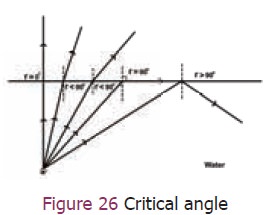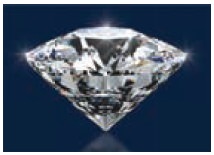Light - Total Internal Reflection | 9th Science : Light
Chapter: 9th Science : Light
Total Internal Reflection
Total Internal Reflection
A demonstration for total internal reflection
Apparatus: Small transparent bottle, Few drops of
Dettol (or some salt); Pointer laser

·
Take some water in a bottle; add a few drops of Dettol or some salt.
·
Point the laser pointer at different angles and note its path
·
At some angle, you will see that the
light gets reflected within the water itself. is is called total
internal reflection.
1. When does total internal reflection takes place?
When light travels from denser medium into a rarer
medium, it gets refracted away from the normal. We know this. While the angle
of incidence in the denser medium increases the angle of refraction also
increases and it reaches a maximum value of r = 90º for a particular angle of
incidence value. is angle of incidence is called critical angle (Figure 26).
Now the refracted ray grazes the surface of separation between the two media.
The angle of incidence at which the angle of
refraction is 90º is called the critical angle.

When the angle of incidence exceeds the value of
critical angle, the refracted ray is not possible, since r > 90º the ray is
totally reflected back to the same medium. This is called as total internal
reflection.
2. Conditions to achieve total internal reflection
·
Light must travel from denser medium to rarer medium. Example from water to air.
·
The angle of incidence inside the denser medium must be greater than that of the critical angle.
Recall
·
Write the relation between the angle of incidence
and the angle of refraction.
·
What is the unit of refractive index?
·
Which has higher refractive index: water or glass?
·
When does refraction take place?
·
When does total internal reflection take place?
3. Total internal reflection in nature
Mirage: On hot
summer days, when you are travelling
on a straight road have you seen the patch of water on the road which keeps
moving ahead as you approach it? is is an illusion sometimes in the desert or
over hot roads. Especially in summer, the air near the ground becomes hotter
than the air at higher levels. The refractive index of air increases with its
density. Hotter air is less dense, and has smaller refractive index than the
cooler air. If the air currents are small, that is, the air is still, the
optical density of different layers of air increases with height. As a result,
light from an object such as a car (See Photo), passes through a medium whose
refractive index decreases towards the ground. us, a ray of light from such an
object successively bends away from the normal and undergoes total internal reflection,
if the angle of incidence for the air near the ground exceeds the critical
angle.

Diamond: Diamonds are known for their spectacular brilliance. Do you know the reason for their brilliance? It is mainly due to the total internal reflection of light inside them. The critical angle for diamond – air interface (θc =24.4º) is very small; therefore once light enters a diamond, it is very likely to undergo total internal reflection inside it. Diamonds faces in nature rarely exhibit the brilliance for which they are known. It is the technical skill of a diamond cutter which makes diamonds to sparkle so brilliantly. By cutting the diamond suitably, multiple total internal reflections can be made to occur.

Why do stars twinkle?
Stars are very far away from us (so appear as
point-like objects); light from the star passes through our atmosphere before
it reaches our eyes. This light bends (refracts) due to the varying densities
and temperature of atmosphere. Moreover, the atmosphere is not stable; it is
very turbulent. Therefore, the light which reaches us appears to come from
different points. This gives the impression that stars are twinkling. If you go
above the atmosphere and see(!), stars do not twinkle. Can you find why do
planets not twinkle?
Optical fibres
Optical fibres are bundles of high-quality
composite glass/quartz fibres. Each fibre consists of a core and cladding. The
refractive index of the material of the core is higher than that of the cladding.
Optical fibres work on the phenomenon of total internal reflection. When a
signal in the form of light is directed at one end of the fibre at a suitable
angle, it undergoes repeated total internal reflection along the length of the
fibre and finally comes out at the other end.
Optical fibres are extensively used for
transmitting audio and video signals through long distances. Moreover, due to
their flexible nature, optical fibers enable physicians to look and work inside
the body through tiny incisions without having to perform surgery.

Recall
1. What are
the examples of total internal reflection in nature?
2. What are
the uses of total internal reflection?
Related Topics